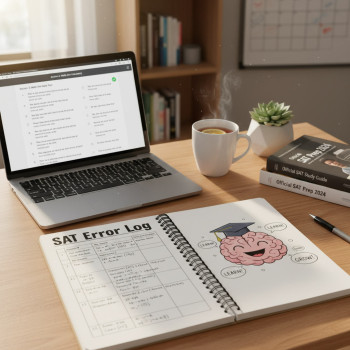Why punctuation matters more than you think on the Digital SAT
When you picture the SAT Reading & Writing section, you might imagine dense passages, sophisticated vocabulary, or tricky rhetorical questions. But tucked inside those passages—often in places where students glance and move on—are punctuation marks doing a lot of heavy lifting. Commas, semicolons, dashes, colons, parentheses, and apostrophes are not just ornaments. They shape meaning, control rhythm, and signal relationships between ideas. On the Digital SAT, where clarity and precision are rewarded, punctuation can be the difference between a correct answer and a subtle trap.
A tiny mark with big consequences
Think of punctuation as traffic signals in a sentence: they tell readers when to pause, merge, or yield. Misplaced punctuation can change the traffic flow—and the meaning—entirely. The SAT Writing & Language questions often test whether you can see how punctuation affects sentence structure and logical flow. That means mastering punctuation isn’t just memorizing rules; it’s learning to read with a punctuation-first mindset.
Core punctuation marks tested on the SAT and what they do
Below are the punctuation marks that appear most frequently on SAT Reading & Writing questions, how they function in context, and the common traps students fall into.
Commas: the most-tested but also the most misunderstood
Commas are everywhere on the SAT. They set off clauses, separate items in lists, and sometimes stand in for omitted words. The key skills the SAT expects:
- Recognize when commas set off nonessential (parenthetical) information versus when the information is essential to the sentence meaning.
- Understand comma splices—when two independent clauses are incorrectly joined by only a comma.
- Use commas correctly with coordinating conjunctions (and, but, for, nor, or, so, yet) to join independent clauses.
Example: “The committee, which meets monthly, approved the policy.” The clause “which meets monthly” is nonessential and should be set off with commas. Removing those commas would change the rhythm and could make the clause appear essential.
Semicolons and colons: siblings with different jobs
Semicolons (;) often appear on the SAT to join two closely related independent clauses without a conjunction. Colons (:) typically introduce a list, a clarification, or an explanation. The SAT will test whether you can identify when the relationship between clauses is strong enough to justify a semicolon or when a colon is the correct signal for what follows.
- Semicolon example: “She wanted to leave early; the meeting ran long.” Both sides are independent clauses that are closely related.
- Colon example: “He had one rule: always check your sources.” A colon prepares the reader for what follows.
Dashes and parentheses: tone and emphasis
Dashes (—) are bold—they create emphasis or an abrupt change. Parentheses are quieter, offering asides that can be removed without ruining the sentence. The SAT may present a sentence with a dash or parentheses and ask whether the punctuation best preserves tone and meaning.
Tip: If removing the dash or parentheses leaves the sentence grammatically intact and with a similar meaning, punctuation is likely being used as a parenthetical aside. If removing it alters emphasis or flow dramatically, think carefully about the writer’s intent.
Apostrophes: possession and contractions
Apostrophes show possession (the student’s book) or contraction (don’t). A surprisingly common SAT trap is confusing plural nouns with possessive nouns (its vs. it’s). Learn to ask two questions: (1) Does the word mean “it is” or “it has”? If yes, use it’s. (2) Is possession being shown? If yes, use its.
How punctuation changes meaning: close-reading with a punctuation lens
To do well on the SAT, don’t just check whether punctuation follows a rule—ask what the punctuation is doing to the sentence’s meaning. Let’s walk through a few quick examples.
Example 1: Comma vs. no comma
“After the meeting the directors, divided over the issue, left quietly.” vs. “After the meeting the directors divided over the issue left quietly.”
In the first sentence, “divided over the issue” is set off as nonessential, making it an aside about the directors; the main idea is that they left quietly. In the second version, the lack of commas makes the phrase seem essential, which is awkward and confusing. Recognition of that distinction often tells you which answer preserves the intended meaning.
Example 2: Semicolon vs. comma splice
“She studied for hours; she still felt nervous.” is correct. “She studied for hours, she still felt nervous.” is a comma splice and usually wrong on the SAT unless joined with a coordinating conjunction. Spotting the splice quickly saves time.
Common SAT punctuation question types—and how to tackle them
On the Digital SAT, many Writing & Language items are presented as multi-choice edits to existing passages. Here are the high-frequency question types related to punctuation and a step-by-step approach to each.
1. Insert or delete punctuation
These questions ask if punctuation should be added or removed. Strategy:
- Read the sentence with and without the punctuation. Which version feels clearer? Which preserves the writer’s emphasis?
- Ask whether the punctuation marks a parenthetical element. If the phrase is removable without changing core meaning, commas, dashes, or parentheses are likely appropriate.
2. Choose punctuation between independent clauses
Decide between a period, semicolon, comma + conjunction, or comma splice. Strategy:
- If the clauses are short and closely linked in thought, a semicolon or comma + conjunction usually works.
- If the clauses express two very distinct sentences, a period is safer.
- Never pick a comma splice.
3. Fix usage in lists and series
Commas separate items in a list. On the Digital SAT, clarity of list items matters—watch for internal commas within list items (which may require semicolons to separate complex list items).
4. Punctuation affecting emphasis or tone
Sometimes the test asks which punctuation best fits the author’s tone. A dash adds drama; parentheses soften a point. Identify the author’s voice in the passage before choosing.
Practical strategies: build a punctuation-first routine
Practicing punctuation on its own is helpful, but the SAT tests punctuation in context. Here’s a three-step routine you can use while practicing passage edits.
Step 1 — Scan for the punctuation hotspots
Before you read for content, scan quickly for commas, semicolons, colons, dashes, and parentheses. These are likely spots for questions.
Step 2 — Read the sentence twice, once for grammar, once for meaning
First, ask: Is the punctuation grammatically correct? Then ask: Does it preserve the sentence’s intended meaning and tone? If grammar and meaning disagree, favor the meaning that matches the passage’s voice.
Step 3 — Use short-elimination logic
On multiple-choice items, eliminate obvious grammar violations first (comma splices, missing commas around nonessential clauses). Then choose the option that best preserves clarity and authorial tone.
Practice techniques that actually stick
Repetition helps, but smart repetition helps more. Here are targeted practice techniques that build intuition quickly.
Micro-practice: 10-minute punctuation drills
- Pick 5 sentences from practice passages. For each sentence, identify the punctuation mark and explain its role in one sentence—out loud or in writing.
- Time yourself. Speed improves with familiarity.
Contrast practice: swap punctuation and feel the change
Take one sentence and rewrite it with different punctuation: replace commas with dashes, replace semicolons with periods. Note how meaning, rhythm, and emphasis change. This trains your ear and eye simultaneously.
Mini peer-review sessions
Explain your punctuation choice to a classmate or tutor. Teaching a concept is one of the fastest ways to cement it.
Helpful summary table: punctuation at a glance
| Punctuation | Primary function | Typical SAT traps | Quick fix / test-time question |
|---|---|---|---|
| Comma (,) | Separate clauses, items, set off nonessential info | Comma splice; missing commas around nonessential clauses | Is the clause removable without changing meaning? |
| Semicolon (;) | Join related independent clauses; separate complex list items | Using it where a comma + conjunction is needed; using where a period is better | Are both sides independent and closely related? |
| Colon (:) | Introduce list/explanation; emphasize an idea | Using a colon before a verb or fragment incorrectly | Does what follows explain or list what’s before? |
| Dash (—) | Add emphasis or abrupt break | Overusing for casual tone; confusion with hyphen | Does the writer want emphasis or a parenthetical aside? |
| Parentheses ( ) | Include quieter, nonessential information | Changing tone in formal writing; parentheses vs commas | Is the aside necessary for the sentence’s logical meaning? |
| Apostrophe (‘) | Show possession or contraction | its vs it’s confusion; incorrect plural possession | Test substitution: can you expand the contraction? Does it show possession? |
Sample timed question and walkthrough
Practice under pressure to build both accuracy and speed. Here is a short sample question and a suggested thought process.
Passage sentence (original)
“The museum opened a new wing last year, the galleries which feature interactive exhibits about climate science are already popular with students.”
What to ask
- Do I have two independent clauses improperly joined?
- What punctuation best clarifies the relationship between the clauses?
- Is there a nonessential clause that should be set off?
Analysis
The phrase “the galleries which feature interactive exhibits about climate science” is meant to describe the new wing. The sentence now reads like a comma splice. A clearer revision: “The museum opened a new wing last year; the galleries, which feature interactive exhibits about climate science, are already popular with students.” The semicolon corrects the splice; the commas set off the nonessential clause.
Real-world reading practice: where to find great material
Beyond SAT practice tests, read well-edited articles—quality newspapers, magazine long-reads, and essays. These sources show punctuation used with purpose: rhetorical dashes in an op-ed, carefully placed commas in narrative nonfiction, and colons in explanatory pieces. When you read, annotate punctuation choices and ask why the author used them.
How tutoring — and Sparkl’s personalized approach — can accelerate your progress
You can make a lot of progress studying alone, but targeted, personalized guidance speeds things up. That’s where 1-on-1 tutoring can transform shaky skills into reliable instincts. Sparkl’s personalized tutoring model pairs you with expert tutors who diagnose your punctuation weaknesses, design tailored study plans, and give focused feedback—often turning recurring errors into mastered concepts in a few sessions.
Some benefits of a personalized approach for punctuation:
- Targeted drills for the punctuation marks you misuse most.
- Real-time corrections and explanations—learning the “why” behind each choice.
- AI-driven insights to track error patterns over time so practice is efficient and not repetitive.
If you’re balancing school, extracurriculars, and test prep, a tutor who tailors sessions to your schedule and needs helps you practice smarter, not harder.
Common mistakes students make—and how to fix them
Knowing the usual traps saves time on test day. Here’s a short list of recurring mistakes and quick fixes you can use in the exam room.
Mistake: Picking the punctuation that sounds “cleanest” rather than the one that preserves meaning
Fix: Always prioritize meaning and tone. Ask, “What does the author want to emphasize or clarify?”
Mistake: Ignoring clauses and relying on instinct
Fix: Identify independent and dependent clauses. Are they complete thoughts? Use that structural knowledge to decide between semicolons, commas, or periods.
Mistake: Misreading lists with internal commas
Fix: When list items contain commas, look for semicolons to separate the items. If no semicolons are present, check whether a punctuation change is needed for clarity.
How to use your remaining study time effectively
With limited weeks left before a test, focus on high-impact habits:
- Daily micro-practice: 10–15 minutes on punctuation rules and targeted drills.
- Weekly full-length practice: Include timed Writing & Language sections to build stamina.
- Error log: Maintain a running list of punctuation errors and review them twice a week.
- 1-on-1 review sessions: Even one or two targeted tutoring sessions per week (for example with Sparkl tutors) can iron out persistent errors quickly.
When punctuation becomes style: choosing the right tone
At advanced levels, punctuation becomes a stylistic tool. The SAT doesn’t test literary flair so much as clarity and appropriate tone. However, recognizing when punctuation is shaping voice helps you pick options that align with the passage’s register. For instance, a conversational passage might properly use a dash for emphasis, while a formal argumentative piece may favor commas or parentheses.
Final checklist for punctuation questions on test day
- Identify clause boundaries: Are you dealing with independent clauses, dependent clauses, or parentheticals?
- Ask if the punctuation affects meaning: Remove the phrase—does the sentence remain coherent?
- Watch for comma splices: Two independent clauses can’t be joined by a comma alone.
- Choose punctuation that matches tone: Emphasis (dash), aside (parentheses/commas), explanation (colon).
- When in doubt, trust grammatical correctness first, then tone.
Parting thought: punctuation is your quiet advantage
Punctuation rarely steals the spotlight, but on the Digital SAT Reading & Writing section it quietly decides many questions. By training your eye to notice punctuation’s role in meaning and tone, and by using targeted practice—micro-drills, contrast exercises, and thoughtful review—you’ll develop instincts that are fast and reliable under pressure.
If you ever feel stuck or want a faster path from confusion to confidence, consider integrating personalized help into your routine. A few sessions focused specifically on punctuation—especially with a tutor who tracks and adapts to your errors—can unlock consistent score improvements. Sparkl’s 1-on-1 guidance, tailored study plans, and analytic insights can make those sessions even more efficient, helping you turn punctuation from something you second-guess into something you own.
Quick practice prompt to try today
Find a short article and pull five sentences that use commas, semicolons, or dashes. For each sentence:
- Explain in one sentence what the punctuation is doing.
- Rewrite the sentence using a different punctuation mark (if possible) and note how the meaning or tone changes.
This 15-minute exercise trains two skills at once: grammatical recognition and sensitivity to nuance. Over time, those fifteen minutes compound into confidence—and higher scores.
Ready to make punctuation predictable?
Approach punctuation as a set of purposeful choices rather than a pile of arbitrary rules. Read with attention, practice with intent, and if you want a faster route to lasting improvement, add a few personalized tutoring sessions into your plan. The small marks you master today will keep paying dividends in clarity, persuasiveness, and your SAT score for years to come. Good luck—and enjoy the satisfying click of a perfectly punctuated sentence.















No Comments
Leave a comment Cancel